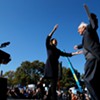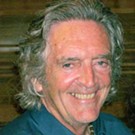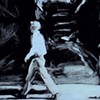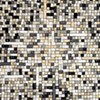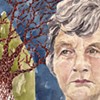Published June 10, 2009 at 11:11 a.m.
The Fleming Museum has the answer for quadricentennial celebrants seeking something more culturally apropos than, say, a Tony Bennett concert.
Curator Aimee Marcereau DeGalan and Manager of Collections and Exhibitions Margaret Tamulonis have organized a multigenre show that examines the natural and human histories of the Champlain Valley through art and artifacts produced by its inhabitants. Paintings, photos, maps, books, tools, toys and furniture tell a story that begins centuries before Samuel de Champlain sailed the lake in 1609.
But this narrative doesn’t unfold chronologically. Instead, the 100-plus pieces are loosely grouped in accordance with four natural elements — earth, water, flora, fauna — that were used either as raw materials or as sources of inspiration.
“A Beckoning Country” begins with Abenaki tools and vessels fabricated a thousand years ago. Alongside them in this “earth” section hang paintings whose subjects relate to Vermont’s geology or landscape. Noteworthy examples include a granite quarry scene by University of Vermont art professor Francis Colburn (1909-1984) and a panorama from the top of Mount Mansfield by contemporary Vermont artist Kathleen Kolb. Her work is paired with a painting that inspired it: a mid-19th-century Champlain Valley vista by Hudson River School artist Sanford Gifford.
Several other intriguing juxtapositions are made possible by the show’s unconventional layout. The “water” section, for example, includes a pair of tiger-maple ice skates made in 1804, as well as a 15-foot-long Abenaki canoe carved from white pine about 50 years before Champlain’s arrival. Archaeologists fished it out of Shelburne Pond in 1978.
Some of the show’s correspondences seem arbitrary or strained. Thomas Curtin’s luminous painting of horses pulling a sled through a Cambridge sugarbush is placed near a Lewis Hine photo of child laborers in a Burlington lumber yard solely because each has something to do with that room’s “flora” theme.
It’s also not clear why the curators chose as the show’s title the slogan used for a 1960s Vermont tourism promo campaign. Could it have something to do with the show’s “participatory” aspect? Vermonters are being solicited to submit Twitter-esque blurbs — 100 words, max — describing objects of personal importance that reflect their feelings about Lake Champlain. Some of these will be incorporated into the show starting next month.
While the overall presentation casts a new light on many of the exhibit’s components, only those viewers unversed in Vermont history will find surprises. The text panels make mostly familiar points about the works on display. However, some details may be enlightening even to local-history buffs. We’re informed, for example, that a building seen in a Curtin painting of the icy Lamoille River was once a boarding house for lumberjacks and is now part of the Vermont Studio Center.
There are a couple of oddities, too. A Dutch/French map from the 17th century situates Lake Champlain to the east of the Connecticut River. And someone stitched a Champ sock puppet in 1959 to mark the 350th anniversary of the French explorer’s lake voyage.
In a show nearly devoid of political content, three photos by Hine stand out for their social significance. The crusading New York photojournalist came to Vermont to document child labor in the lumberyards and woolen mills as part of a campaign to reform work conditions. Hine’s poignant images did help persuade Congress to limit the work week for women and children to a maximum of 58 hours. But the photos aren’t grouped together and are given no prominent treatment. “A Beckoning Country” thereby misses out on the opportunity to celebrate another anniversary: Lewis Hine took those influential pictures in Burlington and Winooski exactly 100 years ago.
Want to see for yourself?
“A Beckoning Country: Art and Objects from the Lake Champlain Valley,” Fleming Museum, UVM, Burlington. Through September 20. Info, 656-0750.
More By This Author
Speaking of...
-

Q&A: Catching Up With the Champlain Valley Quilt Guild
Apr 10, 2024 -

Video: The Champlain Valley Quilt Guild Prepares for Its Biennial Quilt Show
Apr 4, 2024 -

Q&A: Digging Into the Remnants of the Ravine That Divided Burlington
Mar 27, 2024 -

Video: Digging Into the Ravine That Divided Burlington in the 1800s
Mar 21, 2024 -

Q&A: Meet a Family in Waterbury That Embraces Halloween Year-Round
Feb 14, 2024 - More »
Comments
Comments are closed.
From 2014-2020, Seven Days allowed readers to comment on all stories posted on our website. While we've appreciated the suggestions and insights, right now Seven Days is prioritizing our core mission — producing high-quality, responsible local journalism — over moderating online debates between readers.
To criticize, correct or praise our reporting, please send us a letter to the editor or send us a tip. We’ll check it out and report the results.
Online comments may return when we have better tech tools for managing them. Thanks for reading.




































